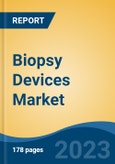Speak directly to the analyst to clarify any post sales queries you may have.
10% Free customizationThis report comes with 10% free customization, enabling you to add data that meets your specific business needs.
Key Market Drivers
Rising Cancer Prevalence
The escalating global incidence of cancer significantly propels the demand for biopsy devices. As cancer becomes more widespread, the need for accurate diagnostic methods grows more urgent. Biopsy procedures are critical in confirming cancer diagnoses, determining types and stages, and guiding effective treatment plans. According to the Union for International Cancer Control (UICC), the number of new cancer cases is projected to exceed 35 million by 2050, marking a 77% increase from 2022. This alarming rise underscores the importance of biopsy tools in healthcare systems, as early and reliable diagnosis is central to improving patient outcomes and expanding access to appropriate therapies.Key Market Challenges
High Cost of Biopsy Procedures
A significant challenge for the global biopsy devices market is the high cost associated with biopsy procedures. These costs include not only the price of specialized equipment but also expenses related to diagnostics, professional services, and post-procedure care. For patients, especially those with limited financial means or inadequate insurance coverage, out-of-pocket expenses can deter timely diagnosis. Even for healthcare providers, the acquisition and maintenance of advanced biopsy equipment, workforce training, and regulatory compliance impose substantial financial burdens. These economic constraints limit accessibility and slow adoption, particularly in developing regions, posing a barrier to market expansion.Key Market Trends
Growth of Minimally Invasive Techniques
The increasing adoption of minimally invasive biopsy techniques is a transformative trend in the global biopsy devices market. Unlike traditional surgical biopsies, these methods - such as fine-needle aspiration, core needle biopsies, and image-guided procedures - offer less invasive alternatives with reduced discomfort and faster recovery. These patient-friendly approaches not only improve diagnostic efficiency but also increase the appeal of biopsy procedures, driving demand. Minimally invasive methods enable sampling from hard-to-reach areas and are associated with lower complication rates. Their growing acceptance among both patients and providers is accelerating market growth and reshaping diagnostic practices across healthcare systems.Key Market Players
- Argon Medical Devices, Inc.
- B. Braun SE
- Becton, Dickinson and Company
- Boston Scientific Corporation
- Cardinal Health, Inc.
- Cook Medical Inc.
- Conmed Corporation
- FUJIFILM Holdings Corporation
- GE HealthCare
- Inrad, Inc
Report Scope:
In this report, the Global Biopsy Devices Market has been segmented into the following categories, in addition to the industry trends which have also been detailed below.Biopsy Devices Market, By Product Type:
- Tissue Biopsy
- Liquid Biopsy
Biopsy Devices Market, By Disease Type:
- Cancer
- Infections
- Autoimmune Disorders
- Non-Cancerous Indications
- Others
Biopsy Devices Market, By Anatomy:
- Breast
- Lung
- Bone
- Liver
- Uterus/Cervix/Ovary
- Abdomen
- Prostate
- Cardiac
- Skin
- Others
Biopsy Devices Market, By Guidance Technique:
- X-Ray-Guided Biopsy
- Ultrasound-Guided Biopsy
- MRI-Guided Biopsy
- CT-Guided Biopsy
Biopsy Devices Market, By Region:
- North America
- United States
- Canada
- Mexico
- Europe
- France
- United Kingdom
- Italy
- Germany
- Spain
- Asia-Pacific
- China
- India
- Japan
- Australia
- South Korea
- South America
- Brazil
- Argentina
- Colombia
- Middle East & Africa
- South Africa
- Saudi Arabia
- UAE
Competitive Landscape
Company Profiles: Detailed analysis of the major companies present in the Global Biopsy Devices Market.Available Customizations:
With the given market data, the publisher offers customizations according to a company's specific needs. The following customization options are available for the report.Company Information
- Detailed analysis and profiling of additional market players (up to five).
This product will be delivered within 1-3 business days.
Table of Contents
Companies Mentioned
- Argon Medical Devices, Inc.
- B. Braun SE
- Becton, Dickinson and Company
- Boston Scientific Corporation
- Cardinal Health, Inc.
- Cook Medical Inc.
- Conmed Corporation
- FUJIFILM Holdings Corporation
- GE HealthCare
- Inrad, Inc
Table Information
| Report Attribute | Details |
|---|---|
| No. of Pages | 180 |
| Published | April 2025 |
| Forecast Period | 2024 - 2030 |
| Estimated Market Value ( USD | $ 6.17 Billion |
| Forecasted Market Value ( USD | $ 8.84 Billion |
| Compound Annual Growth Rate | 6.1% |
| Regions Covered | Global |
| No. of Companies Mentioned | 10 |









